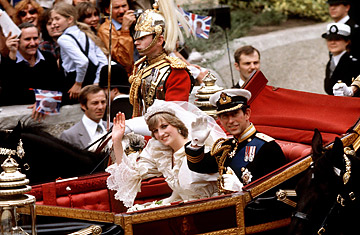
The carriage used by Charles and Diana on their wedding day in 1981 will also carry Prince William and Kate Middleton after their ceremony
Princess Diana took to the world stage in a blaze of white taffeta, as a 19-year-old bride trailed by two tiny attendants. The trumpets that blared on the morning of her wedding on July 29, 1981, did more than mark her arrival at St. Paul's Cathedral: they signaled her uneasy entry into a limelight she would never escape — and, some say, that ultimately killed her. In the days following her 1997 car crash in Paris, as her funeral cortege crawled toward Westminster Abbey, she still commanded the world's attention. But the fanfare had been replaced by the eerie silence of a million mourners. The figures that followed were her two grieving sons.
Fourteen years on, Diana continues to captivate the public and never so strongly as in the run-up to Prince William's wedding on April 29. From the very moment he and Kate Middleton announced their engagement last November, the world began to examine their relationship through a Diana-tinted lens. Is William's relationship with Kate built on firmer foundations than Prince Charles' marriage to Di? Will the young couple pull out all the bells and whistles and throw the wedding of a new century? For supporters of the late Princess, William's story represents another chapter of hers. "Diana would be very proud of her son Prince William and his marriage to Catherine," says royals superfan John Loughrey, 56, who has been camped outside of Westminster Abbey since April 25. "She will be with them in spirit on their special day, and always."
That's not just emotional banter from a royalist. William has said as much himself. When explaining why he proposed to Kate with Diana's sapphire engagement ring, he suggested that he wanted to include his mother in the biggest day of his life. "It's very special to me," he said of the ring after his engagement-day photo call. "It's my way of making sure my mother didn't miss out on today and the excitement and the fact we are going to spend the rest of our lives together." That symbolism of literally holding on to Diana's legacy has cropped up again and again as wedding preparations have unfolded. Lady Sarah McCorquodale, Diana's oldest sister, will attend the event wearing the same earrings that Diana wore to her nuptials in 1981. Featuring a pear-shaped diamond surrounded by 50 smaller diamonds, the earrings were flown back especially from a museum in Kansas City, Mo., where they were on loan with other items from Diana's life. And when Kate and Wills leave Westminster Abbey as man and wife, they'll do so in the 1902 State Landau — the open-top carriage that carried Charles and Diana to Buckingham Palace after their wedding.
But as commentators contemplate these supposed shades of Diana, they lose sight of the fact that the royals do live in a world that occasionally reflects our own, particularly in the realms of human loss and celebration. "Just like the rest of us get out our best silver and crockery for a wedding, they get out their best carriage and Rolls-Royce. It's inevitable," says Sarah Haywood, Britain's most sought-after wedding planner and an authority on multimillion-dollar weddings. "William doesn't think of Diana as a princess. He just sees his lovely mother."
It's important to mention because any princess can amass a collection of jewels and ride in a fancy carriage. Diana was unique because her all-mighty influence stemmed from personal insecurity and vulnerability. Plagued by feelings of worthlessness and blamed by many royals for the breakdown of her marriage, Diana understood life on the margins. She identified with society's outcasts, the men and women living with AIDS and leprosy, and the victims of land mines. They sensed her vulnerability too. Remembering that, her real presence at the wedding won't be felt through the lavish objects, but through the guests who brought her joy and comfort during her life. They include the Rev. Richard Chartres, the man who presided over William's christening and Diana's funeral, who will deliver the wedding address, and Elton John, her close friend who sang "Candle in the Wind" at her funeral. William has also included representatives from groups that Diana championed, like Centrepoint, a homelessness charity, and the Royal Marsden Hospital.
William, who has now lived half his life without his mother, may have moved on in many ways, but surely on momentous days like this one, he can't help but think back to that long walk behind her cortege. "She was straight with him," Patrick Jephson, Diana's private secretary, has said. "She told him he had been born to fulfill a particular duty, that it would be a heavy burden, but that it would also be an opportunity to use his enormous influence for the good of those less fortunate than himself." In that way, through the charities he supports in the name of his mother, he honors her every day — not only when the world is watching.
